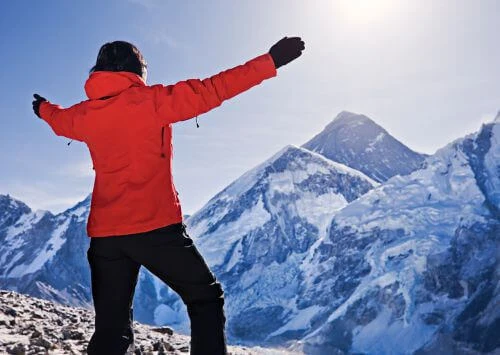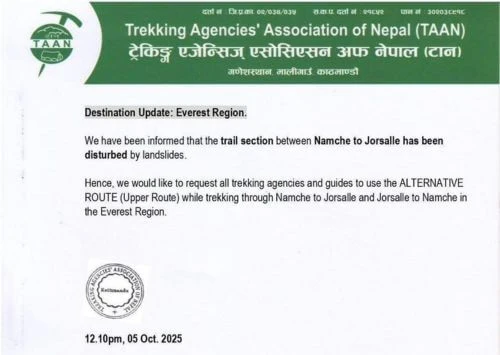Trekking Planner Nepal has prepared a special blog in honor of all the sherpas residing in the Himalayas.
In the heart of the world's highest mountain ranges lies an extraordinary community of people whose resilience and strength have captivated the world. The Sherpas, a Nepalese ethnic group, have long been the unsung heroes behind many successful expeditions to Mount Everest. This is the inspiring story of how these mountaineering superheroes have gone from humble beginnings to conquering the highest peak on Earth.
For generations, the Sherpas have lived in the rugged, unforgiving terrain of the Himalayas, developing exceptional skills and knowledge that make them invaluable assets for climbers attempting to Everest Region. They are renowned for their physical endurance, resilience, and unparalleled expertise in navigating treacherous slopes.
Beyond their incredible mountaineering feats, the Sherpas have also become ambassadors for their culture, showcasing a way of life intrinsically linked to the mountains they call home. As guides, porters, and mentors, they have played a vital role in shaping the world of mountaineering.
Join us as we delve into the fascinating history and culture of the Sherpa people, shining a light on their awe-inspiring accomplishments and the impact they have had on the world of mountaineering. Discover the extraordinary individuals who have dedicated their lives to reaching new heights and enriching our understanding of the Himalayas' majestic beauty.
History and Background of Sherpas
The history of the Sherpa people dates back centuries, with their origins rooted in Tibet. In the 15th century, they migrated from eastern Tibet to the Solu-Khumbu region of Nepal, where they settled and established their unique culture. The word "Sherpa" translates to "people from the east," reflecting their Tibetan heritage.
Living amidst the rugged beauty of the Himalayas, the Sherpas have adapted to the harsh conditions of their environment. Their physical endurance and resilience have been honed through generations of living in high-altitude regions, where the thin air and extreme weather pose constant challenges. This unique adaptation has made them exceptional mountaineers, capable of navigating treacherous slopes with unparalleled expertise.

Sherpas and the Conquest of Mount Everest
The Sherpas' association with Mount Everest began in the early 20th century, when British mountaineers began their expeditions to conquer the world's tallest peak. The Sherpas quickly proved their mettle as indispensable members of these expeditions, providing essential support and expertise.
In 1953, Sir Edmund Hillary and Tenzing Norgay Sherpa made history by becoming the first individuals to reach the summit of Mount Everest. This monumental achievement not only put the Sherpas in the global spotlight but also marked the beginning of a new era for mountaineering. The triumph of Hillary and Norgay opened the floodgates for a wave of mountaineers eager to test their limits and conquer the mighty Everest.
Challenges faced by Sherpas on Everest
The challenges faced by Sherpas on Everest are unparalleled. The extreme altitude, harsh weather conditions, and unpredictable terrain make every expedition a battle for survival. Sherpas often face the daunting task of establishing and maintaining routes, carrying heavy loads of equipment and supplies, and risking their lives to ensure the safety of climbers.
One of the most significant risks that Sherpas face is the threat of avalanches. The Khumbu Icefall, a treacherous section of the Everest route, is notorious for its unstable ice formations and frequent avalanches. Sherpas navigate this treacherous terrain multiple times during each expedition, exposing themselves to considerable danger. Despite the risks, their unwavering commitment to their profession and the climbers they guide is truly awe-inspiring.
The Sherpa community and their culture
The Sherpa community is deeply rooted in their cultural traditions, which are inseparable from their close relationship with the mountains. Their way of life revolves around Buddhism, with monasteries and prayer flags dotting the landscape. Sherpas believe in the spiritual significance of the mountains and follow rituals to seek blessings and protection from the deities believed to reside in the Himalayas.
Education and literacy have also become increasingly important within the Sherpa community. Many Sherpas, recognizing the value of knowledge in an evolving world, have pursued higher education opportunities and become advocates for their community's progress. This has allowed them to bridge the gap between traditional values and modern aspirations, ensuring the preservation of their rich cultural heritage while embracing the opportunities of the 21st century.
The impact of mountaineering on the Sherpa community
The advent of mountaineering has profoundly impacted the Sherpa community, both positive and negative. On one hand, it has opened up avenues for economic growth, as Sherpas have found employment opportunities as guides, porters, and support staff for climbers. This influx of tourism has brought economic prosperity to the region, improving the standard of living for many Sherpas.
However, the commercialization of Everest expeditions has also exposed the Sherpa community to exploitation and risks. The pressure to earn a livelihood has led to overcrowding on the mountain, jeopardizing the safety of climbers and Sherpas alike. Additionally, the Sherpas' role as support staff has often been undervalued, with the focus primarily on the achievements of the climbers. Efforts are being made to address these issues and ensure the fair treatment and recognition of the Sherpa community.
The role of Sherpas in guiding and supporting climbers
Sherpas are the backbone of every Everest expedition. Their expertise in mountaineering and intimate knowledge of the terrain make them invaluable guides and mentors for climbers. They are responsible for setting up camps, fixing ropes, and ensuring the safety of the climbers throughout the ascent.
Sherpas also play a crucial role in carrying heavy loads of equipment and supplies, allowing climbers to focus on their physical and mental preparation. Their strength and endurance enable them to navigate the challenging terrain while bearing the weight of their responsibility. Without the support and guidance of Sherpas, many climbers would find it impossible to conquer Everest.
Famous Sherpas and their achievements
Over the years, numerous Sherpas have made their mark in the world of mountaineering. These extraordinary individuals have achieved remarkable feats, pushing the boundaries of human endurance and resilience. Among them, Apa Sherpa holds the record for the most summits of Everest, having reached the peak 21 times.
Other notable Sherpas include Ang Rita Sherpa, who accomplished the incredible feat of climbing Everest ten times without supplemental oxygen, and Lhakpa Sherpa, the first Nepali woman to summit Everest multiple times. These Sherpas have become role models and inspirations, not only within their community but also for aspiring mountaineers worldwide.
Sherpa-led expeditions and their contributions to mountaineering
In recent years, Sherpa-led expeditions have gained prominence, with Sherpas taking on leadership roles and guiding climbers to the summit. These expeditions have not only showcased the Sherpas' exceptional mountaineering skills but also provided them with the recognition they deserve.
Sherpa-led expeditions have also focused on environmental conservation and promoting sustainable practices on Everest. The Sherpa community understands the importance of preserving the pristine beauty of the mountains and has been actively involved in initiatives aimed at reducing waste and protecting the fragile ecosystem.
Through their leadership, Sherpas are not only making history but also reshaping the narrative of mountaineering, emphasizing the importance of teamwork, respect for nature, and cultural preservation.

Conclusion: The enduring spirit of Sherpas and their legacy
The Sherpas' journey from humble beginnings to conquering Everest is a testament to their indomitable spirit and unwavering dedication. They have not only achieved remarkable mountaineering feats but also become ambassadors for their culture and the mountains they call home.
Despite the challenges they face, the Sherpas continue to inspire awe and admiration with their extraordinary achievements. Their legacy extends beyond mountaineering, encompassing their commitment to their community's progress and the preservation of their cultural heritage.
As we celebrate the Sherpas' remarkable accomplishments, let us also recognize the need to support and uplift their community, ensuring fair treatment and providing opportunities for growth. The Sherpas' story is a reminder that behind every great achievement, there are often unsung heroes whose contributions are invaluable and deserve our utmost respect.
Explore Nepal Trekking Planner's Everest Base Camp Trekking Packages:
Everest Base Camp Trekking: 15 Days
Everest Luxury Lodge Trekking-14 Days
Ama Dablam with Everest Base Camp Trek-15 Days
Everest Base Camp Trek by Road: 17 Days







